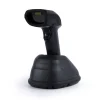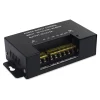RFID readers
RFID readers allow reading the stored string of characters in the selected tag on its proximity to the source of the signal action. This allows quick and convenient control of the flow of goods or people in the enterprise, and thanks to keyboard emulation by simple devices powered by USB cabling, they can transfer the read data to any text field.
=LONG= RFID readers are wired devices designed to identify goods and individuals, operating using radio frequency technology. They allow reading the string of characters stored in the tag. They are characterized by compact size, which saves working space. Likewise, they are made of high-quality materials and have a robust design.
Clear Filters
Clear Filters
Frequency of operation: 125 kHz
Reading method: automatically
Confirmation of scanning: light and sound signal
Interface: USB
Frequency of operation: 125 kHz
Reading method: automatically
Confirmation of reading: light
Power supply: USB DC 5V
Frequency of operation: 125 kHz
Reading method: automatically
Confirmation of reading: light
Interface: USB
Frequency of operation: 125 kHz
Reading method: automatically
Confirmation of reading: light and sound signal
Readable chip types: EM4100, SMC4001, EM4200, EM4305, T5577
Frequency of operation: 125 kHz
Reading method: automatically
Confirmation of reading: light and sound signal
Power supply: USB DC 5V
Frequency of operation: 125 kHz, 13,56 MHz
Reading method: automatically
Confirmation of reading: light and sound signal
Power supply: USB DC 5V
Frequency of operation: 125 kHz
Reading method: automatically
Confirmation of reading: light and sound signal
Reading speed: up to 200 ms
Frequency of operation: 13,56 MHz
Reading speed: up to 200 ms
Reading method: automatically
Power supply: USB DC 5V
RFID readers allow reading the stored string of characters in the selected tag on its proximity to the source of the signal action. This allows quick and convenient control of the flow of goods or people in the enterprise, and thanks to keyboard emulation by simple devices powered by USB cabling, they can transfer the read data to any text field.
=LONG= RFID readers are wired devices designed to identify goods and individuals, operating using radio frequency technology. They allow reading the string of characters stored in the tag. They are characterized by compact size, which saves working space. Likewise, they are made of high-quality materials and have a robust design.

























